Eurocom Monster 1.0: Clevo's Little Monster
by Vivek Gowri on May 18, 2012 4:55 AM EST- Posted in
- Laptops
- Clevo
- Eurocom
- Ivy Bridge
- Kepler
Gaming On the Go? Not Quite
This is where you end up paying for the upgrade to the quad-core CPU when compared to the M11x. The Monster comes with a 62Wh battery, and ends up delivering battery life slightly better than the Alienware M14x but well short of the M11x. The ULV Sandy Bridge chips were phenomenal under idle conditions, so the M11x R3 had awesome idle battery life, but in our real world use case scenarios, the M11x R3 had battery life about 20% better than the Monster. The two previous generations of M11x were similarly more power efficient than the Monster, but it’s a sacrifice worth making for the vastly more powerful CPU.
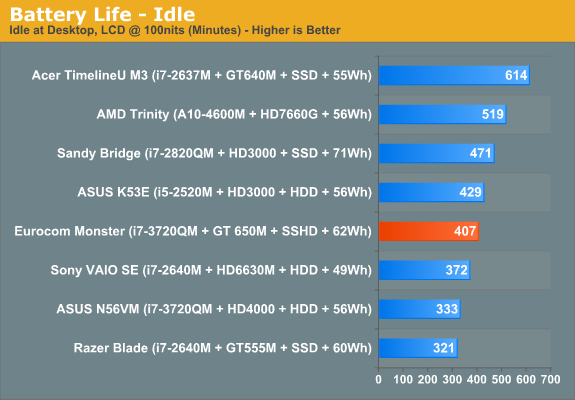
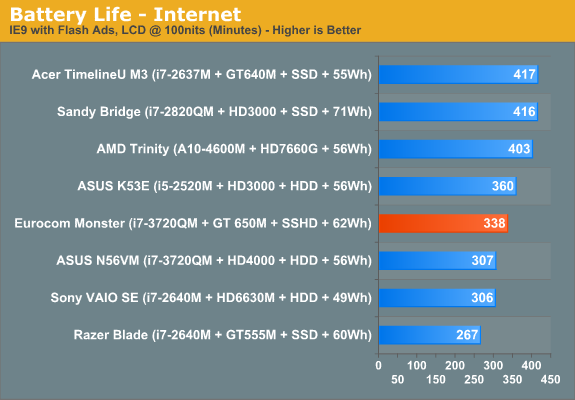
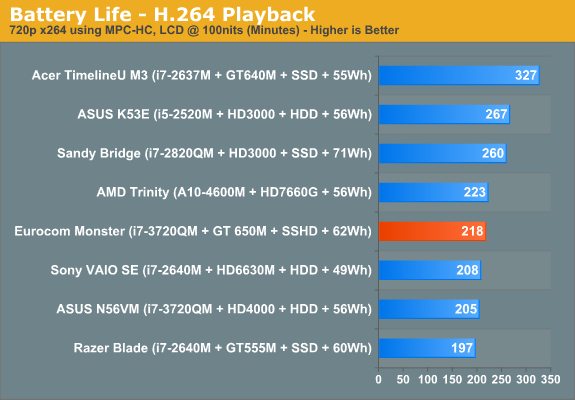

Clevo and Eurocom claim 410 minutes of runtime, and the Monster gets very close to that in our idle battery test, which is the absolute maximum you can expect from the system in an ideal case. Our internet battery test is a much more relevant real world use case scenario, and gives a more realistic estimate of day-to-day battery life, and it slots in at just above 5.5 hours of usable life. I’ve used the Monster as my primary portable for the last ten days or so (including a trip to China) and it’s definitely acquitted itself better than I could have expected.
In terms of gaming battery life (looping 3DMark06), I saw 75 minutes of battery runtime, which is actually pretty decent because we were running the GT 650 in the "prefer maximum performance" setting. For comparison, the ASUS N56VM that served as our IVB test platform ran out of juice at 77 minutes using the HD 4000. But generally, if you're gaming, expect runtime to suffer accordingly.
From a heat standpoint, the numbers aren’t necessarily happy. At idle, temperatures hover in the 60 C range, but load the CPU and GPU and the temperatures climb to the low 90s. I started Furmark and wPrime 1024M (in a loop) and kept it going for a while. After about 10 minutes, temperatures leveled out around 90C for the CPU and motherboard, and 83C for the GPU. That’s….a lot, even higher than the Razer Blade that we tested previously. Do anything more strenuous than surfing and it gets simply too hot to have on your lap. And even under near idle situations like browsing or word processing, the system gets pretty warm to the touch and the fan noticeably kicks in at regular intervals, though unfortunately I don’t have an infrared thermometer to measure the case temps, nor a setup for testing fan noise.
What is very clear though is that the hardware packed into this system is definitely pushing the thermal envelope of the design. There just isn’t enough space to properly ventilate and cool the system via conventional methods. The mechanical engineer in me can think of a few ways that could probably aid in the heat transfer mechanism, but they’re unconventional at best. Quite simply, there needs to either be more surface area to dissipate heat or more airflow to allow for a greater amount of convective heat transfer. Assuming they’re close to constrained for the footprint (which they are, or at least close to it—there’s not too much room to fiddle with the x and y dimensions unless they change the screen size), they just really need to push air through the case. It’s not enough to have a fan for the CPU and GPU, there need to be legitimate case fans, along with a lot more venting. One vent on the left side and a handful of smaller vents on the bottom are clearly not cutting it. Taking certain cooling concepts from desktop cases wouldn’t be a bad idea.


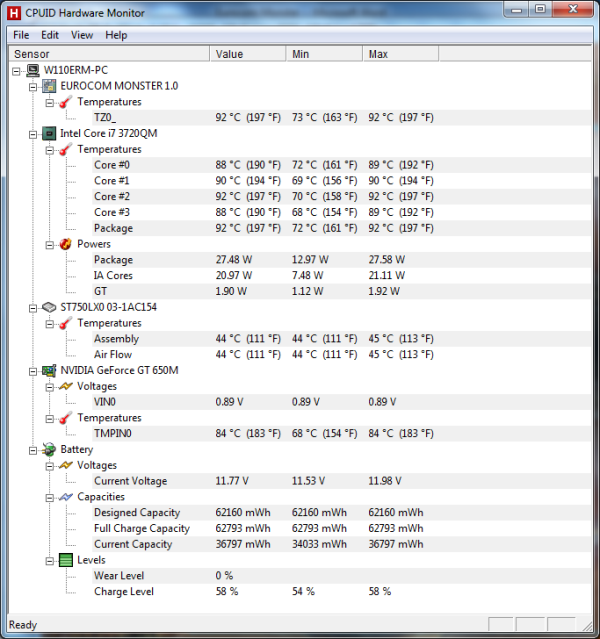
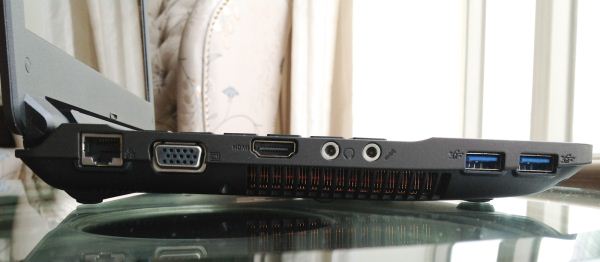








47 Comments
View All Comments
Meaker10 - Friday, May 18, 2012 - link
I meant to say the M14X version is GDDR5 as opposed to the clevo DDR3.ptmmac - Friday, May 18, 2012 - link
I would not be at all surprised if Apple went all in on thin and fast notebooks with high resolution screens. How about an 11" notebook with a much higher resolution screen and the 640GT with thunderbolt, USB3 and OSX? The bigger SSD below would leave space for dual boot as well.Does anyone sell something similar to the phone protection layers that changes a screen from shiny to matte? It doesn't seem that hard to do and would really be a lot cheaper and easier then ordering a separate screen for the same SKU. A matte finish is nothing more than a reduction of the reflectivity of the screen.
Another option as far as the SSD is this 240 Gig SSD from new egg.
http://www.newegg.com/Product/Product.aspx?Item=N8...
It is almost exactly 1$ per gigabyte in price and has twice the room.
Roland00Address - Friday, May 18, 2012 - link
The motherboard does not have any slot for a msata hard drive?drfish - Friday, May 18, 2012 - link
Not that I'm doing the exact same test but I have a 3610QM in mine and I get about 3.5 hours doing what I would consider light Internet browsing... Can you share any more details? I'm running with the default "balanced" Windows power profile and a 128GB Samsung 830, 1.35v RAM, Killer 1102. I am using Opera instead of IE though, lol.BTW, the 1103 will be lacking one of its antennas in this system, only two built in.
JarredWalton - Friday, May 18, 2012 - link
We test at 100 nits brightness (I'm not sure what that works out to for this laptop -- Vivek would have to respond for that), and we use the Power Saver setting. We set the HDD to power off after 1 minute of inactivity, disable screen dimming/power off, set WiFi to maximum power saving, and let the CPU run from 0% to 100% depending on requirements, and we mute the audio. We also test using Internet Explorer. For the web browsing, we load four web pages that have some Flash ads and plenty of images; these pages are refreshed every 60 seconds until power is lost.My experience is that the "Balanced" defaults will usually cut battery life by around 10-15%, and most other browsers aren't quite as power optimized as IE, interestingly enough. They're faster but on average things like Flash use more CPU time I guess. But the bigger factory is probably the number of web pages you have open as well as how often you're loading new web pages, and whether you're doing other things besides just web browsing.
Daniel Egger - Friday, May 18, 2012 - link
Killer Wireless but Realtek GigE? What kind of freak combines the (supposedly) best WLAN implementation with the worst Ethernet chipsets on the planet? Not that any half-way serious player would use opt to use WLAN over a cable anyway...JarredWalton - Friday, May 18, 2012 - link
Have you really had that bad of experiences with Realtek's GigE implementations? Because I've been running GigE in my house for roughly a decade, and generally speaking I've had no complaints with the various chipsets. Some might have lower CPU load, but rarely am I transferring a bunch of data while doing some other tasks that I notice. My general impression is that wired Ethernet controllers have become commoditized for most users -- 2% CPU load vs. 10% load on a quad-core + Hyper-Threading system just doesn't affect me, and sustained transfer rates over 100MiB/s is faster than what most HDDs can handle (though SSDs certainly can hit higher speeds).Daniel Egger - Friday, May 18, 2012 - link
Yes. These things produce all kinds of troubles:- Lousy drivers for various (Windows) OSes, especially new ones like 64bit Windows
- Weak hardware (little buffering, little offloading, outdated communication with the host...) means busy hosts will lose packets very easily -> no reliable connections under CPU load
- Bad and stupid PHYs causing all kinds of nasty errors with long cables, bad shielding, corroded contacts...
This is only covering the basic features, don't let me get started on jumbo frames, vlan support, virtualisation and other "Pro"ish topics.
Long story short: If it says Realteak Ethernet that an absolute dealbreaker for me. Unfortunately this crap is *really* common with certain categories of laptops. :/
JarredWalton - Friday, May 18, 2012 - link
Just to be clear, are you running this stuff in a server or workplace or something? The errors you describe don't sound like home use problems, at least. I've never had issues with cable lengths, but then I've never used any cables more than around 100 ft. Heck, most people with laptops don't even use wired cables at all unless it's at work. I do understand that if you were trying to use a bunch of Realtek chipsets in a business environment with a lot of systems on a network, the list starts to matter a lot more.For home use, though, I've never needed to use any of the "Proish" features you list. YMMV, naturally. Still, it's good to know specifically what types of errors people are running into. If I ever get around to testing GbE chipsets, I'll have to delve a little deeper into the nitty gritty stuff -- not realistically, that's not going to happen.
Daniel Egger - Friday, May 18, 2012 - link
> Just to be clear, are you running this stuff in a server or workplace or something?Coincidentally all of them. But actually the quality matters more in not so tightly controlled environments like simple homes.
> The errors you describe don't sound like home use problems, at least.
All of them tend to be huge problems at home when unskilled people try to run a home network which is very common since many devices do not have WLAN at all like NASses, SIP phones and ATAs, printers or often run quite unreliable when connected to WLANs like STBs, television sets, media players...
> Heck, most people with laptops don't even use wired cables at all unless it's at work.
I would not be so sure of that. WLAN is still slow when compared to GigE, unreliable and quite problematic in multi-story brick and mortar or concrete building (even more so with floor heating) and in dense cities. Where I live WLANs are mostly used as slow backup and for mobile phones.
And in fact I rather doubt that any serious gamer (the target group for the Eurocom Monster?!?) will be using WLAN at a party even if it actually was available.
> I do understand that if you were trying to use a bunch of Realtek chipsets in a business environment with a lot of systems on a network, the list starts to matter a lot more.
Rather the opposite. In businesses you typically have high quality calibrated cabling and switches which will adapt cable lengths and and bad client chipsets ... and alert sysadmin when links drop too often or too many packets are lost. It's almost impossible that a Realtek chipset will mess that up. ;)